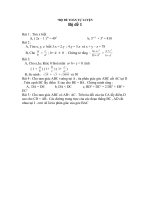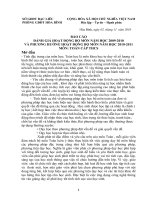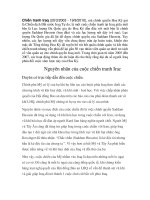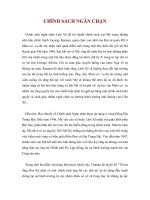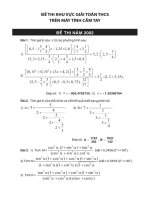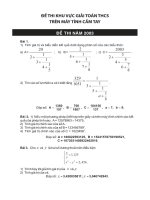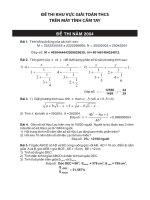facts and factors grade 7 Bộ Sách Toán THCS Của Mỹ
Bạn đang xem bản rút gọn của tài liệu. Xem và tải ngay bản đầy đủ của tài liệu tại đây (2.94 MB, 72 trang )
Facts and
Factors
Number
CuuDuongThanCong.com
/>
Mathematics in Context is a comprehensive curriculum for the middle grades.
It was developed in 1991 through 1997 in collaboration with the Wisconsin Center
for Education Research, School of Education, University of Wisconsin-Madison and
the Freudenthal Institute at the University of Utrecht, The Netherlands, with the
support of the National Science Foundation Grant No. 9054928.
This unit is a new unit prepared as a part of the revision of the curriculum carried
out in 2003 through 2005, with the support of the National Science Foundation
Grant No. ESI 0137414.
National Science Foundation
Opinions expressed are those of the authors
and not necessarily those of the Foundation.
Abels, M., de Lange, J., and Pligge, M.,A. (2006). Facts and Factors.
In Wisconsin Center for Education Research & Freudenthal Institute (Eds.),
Mathematics in Context. Chicago: Encyclopædia Britannica, Inc.
Copyright © 2006 Encyclopædia Britannica, Inc.
All rights reserved.
Printed in the United States of America.
This work is protected under current U.S. copyright laws, and the performance,
display, and other applicable uses of it are governed by those laws. Any uses not
in conformity with the U.S. copyright statute are prohibited without our express
written permission, including but not limited to duplication, adaptation, and
transmission by television or other devices or processes. For more information
regarding a license, write Encyclopædia Britannica, Inc., 331 North LaSalle Street,
Chicago, Illinois 60610.
ISBN 0-03-038564-4
1 2 3 4 5 6 073 09 08 07 06 05
CuuDuongThanCong.com
/>
The Mathematics in Context Development Team
Development 2003–2005
Facts and Factors was developed by Meike Abels and Jan de Lange.
It was adapted for use in American schools by Margaret A. Pligge.
Wisconsin Center for Education
Freudenthal Institute Staff
Research Staff
Thomas A. Romberg
David C. Webb
Jan de Lange
Truus Dekker
Director
Coordinator
Director
Coordinator
Gail Burrill
Margaret A. Pligge
Mieke Abels
Monica Wijers
Editorial Coordinator
Editorial Coordinator
Content Coordinator
Content Coordinator
Margaret R. Meyer
Anne Park
Bryna Rappaport
Kathleen A. Steele
Ana C. Stephens
Candace Ulmer
Jill Vettrus
Arthur Bakker
Peter Boon
Els Feijs
Dédé de Haan
Martin Kindt
Nathalie Kuijpers
Huub Nilwik
Sonia Palha
Nanda Querelle
Martin van Reeuwijk
Project Staff
Sarah Ailts
Beth R. Cole
Erin Hazlett
Teri Hedges
Karen Hoiberg
Carrie Johnson
Jean Krusi
Elaine McGrath
CuuDuongThanCong.com
/>
(c) 2006 Encyclopædia Britannica, Inc. Mathematics in Context
and the Mathematics in Context Logo are registered trademarks
of Encyclopædia Britannica, Inc.
Cover photo credits: (all) © Getty Images
Illustrations
1 (top) Michael Nutter/© Encyclopædia Britannica, Inc.; (bottom)
Holly Cooper-Olds; 2, 3, 4, 13 Christine McCabe/© Encyclopædia
Britannica, Inc.; 18, 24 (left), 25, 27, 34 (left), 36 Holly Cooper-Olds;
38 Christine McCabe/© Encyclopædia Britannica, Inc.; 45, 50 (top)
Holly Cooper-Olds; 51, 56 Christine McCabe/© Encyclopædia
Britannica, Inc.
Photographs
3 Sam Dudgeon/HRW Photo; 6 © Richard T. Nowitz/Corbis; 8, 9 (top)
Victoria Smith/HRW; (bottom) R. Stockli, A. Nelson, F. Hasler,
NASA/GSFC/NOAA/USGS; 12 Victoria Smith/HRW; 13 (top)
Sam Dudgeon/HRW Photo; (bottom) PhotoDisc/Getty Images;
14 (top left) PhotoDisc/ Getty Images; (top right) G. K. & Vikki Hart/
PhotoDisc/Getty Images; 15 © ImageState; 30 © Corbis; 37 Sam
Dudgeon/HRW Photo; 38, 39 Victoria Smith/HRW; 40 Stephanie
Friedman/HRW; 41 © PhotoDisc/Getty Images; 44 Don Couch/
HRW Photo; 49 Sam Dudgeon/HRW Photo; 55 Archives Académie
des Sciences, photo Suzanne Nagy; 56 Lisa Woods/HRW
CuuDuongThanCong.com
/>
Contents
Letter to the Student
Section A
Base Ten
Hieroglyphics
Times Ten
Large Numbers
Exponential Notation
Scientific Notation
Summary
Check Your Work
Section B
24
2
12
6
2
24
27
29
30
32
33
2
3
Square and Unsquare
Square
Unsquare
Cornering a Square
Not So Square
Summary
Check Your Work
Section E
13
17
17
21
22
23
Prime Numbers
Upside-Down Trees
Primes
Prime Factors
Cubes and Boxes
Summary
Check Your Work
Section D
1
3
6
7
8
10
11
Factors
Pixels
Facts
Factors
Changing Positions
Summary
Check Your Work
Section C
vi
35
37
37
40
42
43
More Powers
The Legend of the Chess Board
Powers of Two
Powers of Three
Different Bases
Back to the Egyptians
Summary
Check Your Work
44
46
48
48
50
52
53
Additional Practice
54
Answers to Check Your Work 60
Contents v
CuuDuongThanCong.com
/>
Dear Student,
The numbers we use today are widely
used by people all over the world.
This might surprise you since there
are about 190 independent countries in the world, speaking over
5,000 different languages! This was not always the case. In the
unit Facts and Factors, you will investigate how ancient civilizations
wrote numbers and performed number computations. Looking into
the past will help you make more
sense of the way you write and
compute with numbers. You will
look into other numbering
systems in use today.
You will investigate some properties of digital photographs. By doing
so, you will learn more about the properties of numbers. How many
different pairs of numbers can you multiply to find a product of 36?
How about for a product of 51 or 53? You will expand your
understanding of all the real numbers.
We hope you enjoy this unit.
Sincerely,
The Mathematics in Context Development Team
vi Facts and Factors
CuuDuongThanCong.com
/>
A
Base Ten
Hieroglyphics
MEDITERRANEAN SEA
Alexandria
N
Rosetta
Giza
Memphis
S
SINAI
AR
AB
LOWER
EGYPT
IA
N
Tell
El-Amarna
Thebes Karnak
Abydos
Valley of
UPPER the Kings Luxor
EGYPT
Edfu
Aswan
1st Cataract
Philae
D
SE
Tropic of Cancer
DE
Abu Simbel
SE
2nd Cataract
R iver
This hieroglyph
Nil
e
RT
0
0
A
RT
N
Here is his latest work. The hieroglyphs on
the stone represent the number 1,333,331.
SE
DE
YA
He carved little pictures called
hieroglyphs to record information.
RE
r
LIB
At this time, Horus was the best stone
carver of his village.
E
Heliopolis
Cairo
N i l e R iv e
Step back in time to a world without
computers, calculators, and television;
to Egypt around 3000 B.C.
DE QAT
P R TA
ES RA
SI
ON
W
100
NUBIA
200 mi
100 200 300 km
is an astonished man. Perhaps he is astonished
because he represents a very large number.
1. What number does
the astonished man represent?
Section A: Base Ten 1
CuuDuongThanCong.com
/>
A Base Ten
Here is the number 3,544 written in hieroglyphics.
2. How would Horus write your age? And 1,234?
Today, we use the Arabic system and the numerals 0, 1, 2, 3, 4, 5, 6, 7,
8, and 9 to represent any number.
3. Complete the table on Student Activity Sheet 1 to compare the
Egyptian hieroglyphs with the Arabic numerals we use today.
Egyptian
Hieroglyph
Egyptian
Description
Arabic
Numeral
English
Word
1
one
vertical stroke
a heel bone
a coil or rope
lotus flower
pointing finger
tadpole
an astonished
man
4. What number is represented in this drawing?
5. How would Horus write 420? And 402?
6. How many Egyptian hieroglyphs do you need to draw the
number 999?
2 Facts and Factors
CuuDuongThanCong.com
/>
Base Ten A
You found these three pieces of a stone containing Egyptian
hieroglyphs.
7. What number do they represent when placed altogether?
Today, Peter found these three tiles lying
on the ground by an abandoned house.
8. Can you figure out the address of this
house? Why or why not?
9. What are the differences between our
Arabic system of writing and using
numbers and the Egyptian system?
Times Ten
10. a. Draw the Egyptian number that is
ten times as large as this one.
b. Describe what the ancient
Egyptians would do to multiply
a number by ten.
In our Arabic number system, numerals in a number are called digits.
Digits have a particular value in a number.
For example, in the number 379:
The digit 3 has a value of 3 hundreds.
The digit 7 has a value of 7 tens.
The digit 9 has a value of 9 ones.
Section A: Base Ten 3
CuuDuongThanCong.com
/>
A Base Ten
You can expand the number 379 with words as 3 hundreds and 7 tens
and 9 ones or as 3 ؋ 100 ؉ 7 ؋ 10 ؉ 9 ؋ 1.
11. Expand the following numbers in the same way.
a. 628
b. 2,306
c. 256
d. 2,560
12. Compare your answer to 11c and d. What do you notice?
The pictures here compare multiplying a number by 10 for both
number systems.
Ancient Egyptian Hieroglyphics vs. Arabic Number System
537
؋ 10
؋ 10
5370
Sasha looks at the hieroglyphics and notices, “When you multiply a
number by 10, you only have to change each hieroglyph into a
hieroglyph of one value higher.”
13. a. Explain what Sasha means. Use an example in your
explanation.
b. What is the value of 7 in 537? And what is the value of
7 in 5,370?
c. What is the value of 3 in 537? And in 5,370?
d. Explain what happens to the value of the digits when you
multiply by ten.
e. Calculate 26 ؋10 and 2.6 ؋10.
f. Does your explanation from d hold for problem e?
If not, revise your explanation.
4 Facts and Factors
CuuDuongThanCong.com
/>
Base Ten A
The Egyptian number system was not well suited for decimal or
fraction notation. The decimal notation we use today was developed
almost 4,000 years later. A Dutch mathematician, Simon Stevin,
invented the decimal point.
14. a. Explain the value of each digit in the number 12.574.
1
1
᎑᎑᎑᎑᎑᎑
as a single number.
b. Write 7 ؋ 100 ؉ 6 ؋ 1 ؉ 4 ؋ ᎑᎑᎑
10 ؉ 5 ؋ 1000
If you multiply a decimal number by 10, the value of each digit is
multiplied by 10.
tens
ones
tenths
hundredths
hundreds
Consider the product of 57.38 ؋ 10.
5
7
3
8
؋ 10
5
7
3
8
57.38 ؋ 10 ؍573.8
1
1
᎑᎑᎑᎑
57.38 ؍5 ؋ 10 ؉ 7 ؋ 1 ؉ 3 ؋ ᎑᎑᎑
10 ؉ 8 ؋ 100
1
573.8 ؍5 ؋ 100 ؉ 7 ؋ 10 ؉ 3 ؋ 1 ؉ 8 ؋ ᎑᎑᎑
10
؋ 10
15. Calculate each product without using a calculator.
a. 4.8 ؋ 10
b. 4.8 ؋ 10 ؋ 10
c. 6.37 ؋ 10 ؋ 10
d. 9.8 ؋ 10 ؋ 10 ؋ 10
e. 1.25 ؋ 1,000
f. 0.57892 ؋ 1,000
Section A: Base Ten 5
CuuDuongThanCong.com
/>
A Base Ten
Large Numbers
Numerals
1
10
100
1,000
10,000
100,000
1,000,000
10,000,000
100,000,000
1,000,000,000
10,000,000,000
100,000,000,000
1,000,000,000,000
Words
one
ten
one hundred
one thousand
ten thousand
one hundred thousand
one million
ten million
one hundred million
one billion
ten billion
one hundred billion
one trillion
In 2004, the population of the United States was about 292 million,
and the world population was about 6 billion.
16. Write these populations using only numerals.
Notice that commas separate each group of three digits. This
makes the numbers easy to read. You read the number 2,638,577
as “two million, six hundred thirty-eight thousand, five hundred
seventy-seven.”
17. How do you read 4,370,000? And 1,500,000,000?
There are different ways to read and write large numbers. For
example, you can read 3,200,000 as: “three million, two hundred
thousand” or simply as “3.2 million.”
18. Write at least two different ways you can read each number.
a. 6,500,000
b. 500 million
c. 1.2 thousand
d. 750,000
6 Facts and Factors
CuuDuongThanCong.com
/>
Base Ten A
19. Find each product and write your answers using only words.
a. One million times ten
b. One hundred times one hundred
c. One thousand times one thousand
20. a. How many thousands are in one million?
b. How many thousands are in one billion?
c. How many millions are in one billion?
d. Use numbers such as 10, 100, 1,000, and so on, to write five
different multiplication problems for which the answer is
1,000,000.
21. Suppose you counted from one to one million and every count
would last one second. How long would this take?
Exponential Notation
To save time writing zeroes and counting zeroes, scientists invented a
special notation, called exponential notation.
The number 1,000 written in exponential notation is 103 (read as
“ten raised to the third power” or “ten to the third”).
1,000 ؍103 because 1,000 ؍10 ؋10 ؋10
10
3
exponent
base
In 103, the 10 is the base, and the 3 is the exponent.
22. Write each number in exponential notation.
a. 100
b. 1,000,000,000
c. 10,000,000,000
23. Write each number in numerals and words.
a. 104
b. 101
c. 106
Section A: Base Ten 7
CuuDuongThanCong.com
/>
A Base Ten
Scientific Notation
How does your calculator display large numbers? To find out, answer
the following:
24. a. On a calculator, enter 9s until all places on the display are
occupied. Record the number displayed in your notebook.
b. Without using the calculator, what happens when you add 1
to this number? Calculate the answer in your notebook. Write
your answer in exponential notation. Identify the base and
the exponent.
c. Now, use your calculator to add 1 to the large number
displayed (the one with all 9s). Record the new number
displayed.
d. Explain what each part of the number displayed means.
e. In your notebook, calculate the product of 2,000,000,000 ؋
3,000,000,000. Verify your calculation using your calculator.
If needed, revise your answer for part d.
For very large numbers, most calculators switch to scientific notation
(Sci) mode. The display shows a number between 1 and 10 and a
power of ten.
Calculators display scientific notation in a variety of ways. Here are
two different calculator displays for the 2004 world population
of 6,400,000,000 people.
6.4
09
6.4 E 09
The number that is displayed is the product: 6.4 ؋ 109.
8 Facts and Factors
CuuDuongThanCong.com
/>
Base Ten A
25. a. Write 6.4 ؋ 109 in numerals and words.
b. What numbers are displayed here?
4
06
3.8
04
The distance from the earth to the moon is approximately
240 thousand miles.
26. How would your calculator display this distance in scientific
notation?
Section A: Base Ten 9
CuuDuongThanCong.com
/>
You can expand the number 79.54 as:
1
1
᎑᎑᎑᎑
7 ؋ 10 ؉ 9 ؋ 1 ؉ 5 ؋ ᎑᎑᎑
10 ؉ 4 ؋ 100
ones
7
9 . 5
hundredths
tens
The Arabic Number System you use today
is a positional system using the numerals
0 through 9. The position of each digit in a
number determines its value. You can read
the number 79.54 as “seventy-nine and
fifty-four hundredths.”
tenths
A Base Ten
4
4 hundredths
5 tenths
9 ones
7 tens
5
4
᎑᎑᎑᎑
or 70 ؉ 9 ؉ ᎑᎑᎑
.
10 ؉ 100
Multiplying by Ten
If you multiply a decimal number by 10, the value of each digit is
multiplied by 10.
tens
ones
tenths
hundredths
hundreds
For example: 79.54 ؋ 10
7
9
5
4
9
5
4
؋ 10
7
79.54 ؋ 10 ؍795.4
79.54
795.4
1
1
᎑᎑᎑᎑
؍7 ؋ 10 ؉ 9 ؋ 1 ؉ 5 ؋ ᎑᎑᎑
10 ؉ 4 ؋ 100
؍7 ؋ 100 ؉ 9 ؋ 10 ؉ 5 ؋ 1 ؉ 4 ؋
1
᎑᎑᎑
10
10 Facts and Factors
CuuDuongThanCong.com
/>
؋ 10
Exponential Notation
Exponential notation is a shorter way to write repeated multiplication.
For example: 10 ؋ 10 ؋ 10 ؋ 10 ؋ 10 ؋ 10 ؋ 10 ؍107.
You can read 107 as “ten to the seventh power” or “ten to the seventh.”
In 107, the 10 is the base, and
the 7 is the exponent.
10
7
exponent
base
Scientific Notation
Calculators display very large numbers using scientific notation.
The number is displayed as a product of a number between 1 and 10
and a power of ten.
A calculator displaying
4.5 07
represents
the product 4.5 ؋ 107 ؍4.5 ؋ 10,000,000
؍45,000,000
1. Calculate the following without using a calculator.
a. 1,000 ؋ 10 ؋ 10
d. 63.7 ؋ 100
b. 1,000 ؋ 1,000
e. 0.58 ؋ 1,000
c. 63.7 ؋ 10
2. a. Use numbers such as 10, 100, 1,000, and so on, to write five
different multiplication problems for which the answer is one
billion.
b. Write five more multiplication problems similar to those in part
a, but for which the answer is 2,270,000.
Section A: Base Ten 11
CuuDuongThanCong.com
/>
A Base Ten
3. Calculate the following and write your answers three different
ways: in exponential notation, as a single number, and in words.
a. 104 ؋ 103
b. 1,000,000 ؋10,000
c. ten ؋ one hundred ؋ one thousand
d. one thousand ؋ one million
4. a. Fill in the missing exponents and then write the answer as a
single number.
2.25 ؋ 104 ؍
22.5 ؋ 10? ؍
225 ؋ 10? ؍
b. Make up a problem similar to the one in a. Ask a classmate to
solve your problem.
Here are two different calculator
displays of the same number.
5.1
06
5.1 E 06
5. a. Explain what is displayed.
b. Write this number as a
single number.
Write a short paragraph for a school newsletter describing the
benefits of using scientific notation for very large numbers.
12 Facts and Factors
CuuDuongThanCong.com
/>
B
Factors
Pixels
Jacqui and Nikki are friends. They used to be
neighbors, but Nikki moved to Cleveland. Now
they maintain their friendship by using the
Internet. They send e-mail to each other and
chat online at least once a day.
Today after school, Jacqui checks her e-mail. After
about three minutes, she realizes Nikki’s message
is taking longer than usual to download. After
waiting impatiently for ten minutes, Jacqui asks
her brother, “Dave, what can I do? Look at that bar
on the computer screen!”
Here is a screen shot of the bar on Jacqui’s computer after 12 minutes.
1. Estimate how many more minutes Jacqui will have to wait to
download this message completely. Show how you found
your answer.
Nikki’s e-mail included a picture with her
new puppy.
Dave remarks, “It’s a cute picture, but the
size of the file is too large. Send her an
e-mail and tell her that she has to make
the files smaller before she sends them.”
Jacqui says, “Dave, how can she do that?
I don’t even know how to do that.”
Dave shares what he knows about digital
pictures.
Section B: Factors 13
CuuDuongThanCong.com
/>
B Factors
A digital picture is made up of many little colored squares. These little
squares are PICture ELements, or pixels.
The number of pixels determines the file size:
the more pixels, the larger the file size.
Here is a smaller file of Nikki and her dog.
The number of pixels has decreased
dramatically: you can now see the pixels.
You will now investigate the effect of changing
the number of pixels per inch (ppi).
Pictures 1, 2, and 3 are the same picture.
Picture 1 has side lengths of two inches.
2. a. How many pixels do you count along one inch?
b. What is the total number of pixels in Picture 1?
Picture 2 shows the same pixel pattern but uses more
pixels per inch (ppi).
3. a. How many pixels per inch are in Picture 2?
Picture 1
b. Without counting, what can you tell about the
number of pixels per inch in Picture 3?
Compare Pictures 1, 2, and 3.
4. Describe how the pictures are the same and how
they are different.
Picture 2
You probably didn’t find the total number of pixels
by counting all the small squares. For counting the
pixels in Picture 1, you may have multiplied 12 ؋ 12.
Whenever you multiply a number by itself, you are
squaring the number.
Picture 3
5. Why do you think the expression “squaring a
number” is used?
14 Facts and Factors
CuuDuongThanCong.com
/>
Factors B
Two ways to indicate squaring the number 12 are 122 or 12^2. Both
represent 12 ؋ 12, which gives an answer of 144.
Picture 1 has 12 pixels along each side, for a total of 122, or 144 total
pixels.
Numbers like 144, which result from squaring a number, are called
square numbers or perfect square numbers.
6. Find at least five different perfect square numbers. Share your list
with a classmate. See if each of you can guess the number before
it was squared.
Earlier, you compared the same pixel pattern for three different sized
pictures. The pictures became smaller, but the total number of pixels
did not change.
If you want to reduce the size of a picture file, then
you must reduce the total number of pixels. You will
now investigate ways to reduce the number of pixels
by changing the number of pixels per inch (ppi).
This square picture of a pink rose has sides of 1 inch.
7. a. What is the total number of pixels if there are 200 ppi?
b. What is the total number of pixels if there are 100 ppi?
Note that the sides of the picture stay 1 in.
And 50 ppi? And 25 ppi?
c. Copy this table and record your answers from b in column 2.
Describe how the pixels per inch (ppi) in column 1 change
from row to row.
ppi
Total Number of Pixels
Download Time
200
100
50
25
d. How does the total number of pixels decrease as the number
of pixels per inch is cut in half?
e. The download time decreases as the total number of pixels
decrease.The download time for a 200 ppi picture is16 seconds.
Use this information to fill in the last column of your table.
Section B: Factors 15
CuuDuongThanCong.com
/>
B Factors
The picture Nikki included with her e-mail had 400 ppi and dimensions of 3 in. by 4 in.
8. How many total pixels were in the picture Nikki e-mailed? Show
your calculations.
In the unit Expressions and Formulas, you used arithmetic trees to
help organize your calculations.
4
400
3
؋
?
______
400
400
؋
?
______
؋
?
______
400
3
؋
?
______
4
؋
?
______
؋
?
______
9. Explain how each arithmetic tree relates to problem 8.
10. a. Without changing the size of her picture (3 in. by 4 in.), Nikki
reduced the number of pixels to 200 ppi. How many total
pixels make up Nikki’s new picture?
b. Use the information from Nikki’s picture to copy and complete
this table.
ppi
Total Number of Pixels
400
200
100
c. In the table, the number of ppi is cut in half. What happens to
the total number of pixels?
Jacqui waited about 48 minutes for Nikki’s original picture to download.
11. a. What would have been the download time if the picture had
200 ppi instead of 400 ppi?
b. And if the picture had 100 ppi?
16 Facts and Factors
CuuDuongThanCong.com
/>
Factors B
Facts
Here is Nikki’s picture reduced too much—
it has just five pixels per inch.
Images appear nicely on a computer screen
if there are at least 72 pixels per inch.
Factors
In the previous problem, you might have calculated the total
number of pixels by using division: 480,000 ، 4 ___؍, or
multiplication: 4 ؋ ___ ؍480,000.
Division and multiplication operations relate to each other in this way.
Using either operation, you found that the total number of pixels
decreased from 480,000 to 120,000. Two number sentences for this
context are 480,000 ، 4 ؍120,000, and 4 ؋ 120,000 ؍480,000.
The whole numbers 4 and 120,000 are called factors of 480,000.
12. a. Find four different factors of 48.
b. Can you find a factor of 45 without making a calculation?
Explain.
c. How do you know that 2 is not a factor of 45?
You may remember some divisibility rules. Divisibility rules involve
division of whole numbers without any remainders. Here are three
divisibility rules:
• A number is divisible by 3 if the sum of the digits is divisible by 3.
• A number is divisible by 4 if the last two digits form a number
that is divisible by 4.
• A number is divisible by 9 if the sum of its digits is divisible by 9.
13. a. Is 2,520 divisible by 3? By 4? By 9?
b. Is 2,520 divisible by 5? Write a rule for divisibility by 5.
c. How can you check whether or not 2,520 is divisible by 6?
d. What other rules for divisibility do you know?
Section B: Factors 17
CuuDuongThanCong.com
/>
B Factors
Jacqui prints 24 square pictures. She wants to use all 24 pictures to
make a rectangular display in her room.
She begins to investigate all possible arrangements so she can
choose the one she wants. First, she sketches one rectangular
arrangement.
Then she decides to make a list of all possible arrangements.
Jacqui’s 24 pictures:
One possible rectangular arrangement of 24 pictures: 6 across
and 4 vertical:
List of all possible rectangular arrangements:
1 by 24
2 by 12
3 by 8
4 by 6
6 by 4
8 by 3
12 by 2
24 by 1
She asks Dave if she has them all. Dave sees the list and says, “I think
1 by 24 is the same as 24 by 1.”
14. Do you agree with Dave? Why or why not?
18 Facts and Factors
CuuDuongThanCong.com
/>
Factors B
24
Jacqui decides to draw one of
her picture arrangements on
graph paper.
22
20
18
16
14
12
10
8
6
4
2
0
24
4
2
6
8
10
12
14
16
18
20
22
24
Here is a graph showing all of
the rectangular arrangements
in Jacqui’s list.
(1, 24)
22
15. a. Explain what the graph
shows.
20
18
b. How would you label
the axes?
16
14
c. Describe what each pair
of coordinates has in
common.
(2, 12)
12
10
Since 3 ؋ 8 ؍24, 3 and 8 are
factors of 24.
(3, 8)
8
(4, 6)
6
16. List all of the possible
factors of 24.
(6, 4)
4
(8, 3)
(12, 2)
2
(24, 1)
0
2
4
6
8
10
12
14
16
18
20
22
How can you be sure you
have them all?
24
Section B: Factors 19
CuuDuongThanCong.com
/>

